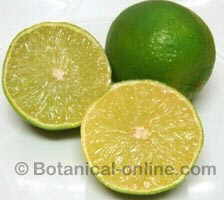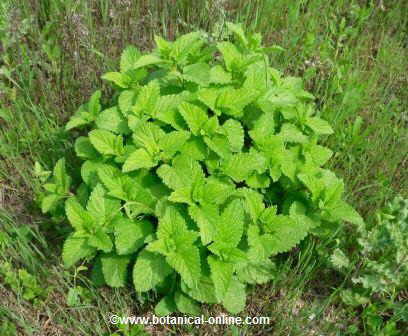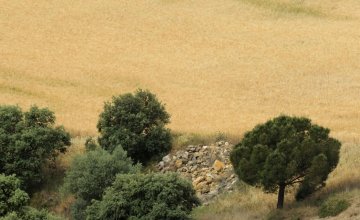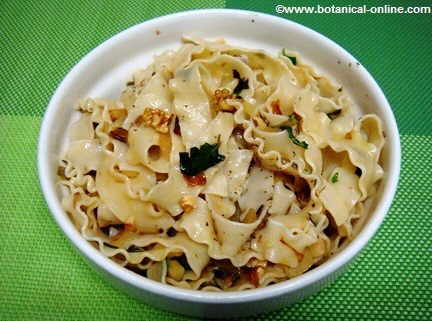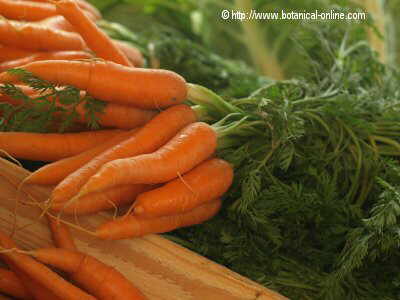Edible properties of barley
Barley is a very energetic food
Barley, like the rest of cereals, is a food that provides a great energy (354 kcal/100g). The energy content of barley comes mainly from its wealth in carbohydrates. (76, 38%). Compared with other cereals, (74.2%) it has more hydrates than maize, wheat (68, 3%) or oats (66, 27%), although a little less than whole rice (77, 24%).
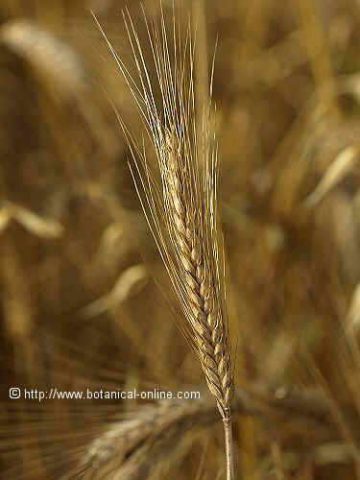
Barley is rich in sugars or complex carbohydrates, mainly starch and cellulose and minor amounts of maltose and raffinose. On a smaller scale, it also contains simple carbohydrates such as fructose and glucose and other sugars.
The starch in the barley grain is primarily responsible for barley to be such a energetic food. It provides useful energy to the body, both for our daily activities, or for involuntarily body activities when being at rest, which is known as basal metabolism. It is not surprising the fame of this food in antiquity as “invigorating food.”
At present it has been verified that, more interesting than its energy content, is the form in which this component provides this energy. Barley contains much starch and the starch is a complex carbohydrate that requires the body to undertake a series of transformations to convert it into glucose so it can be absorbed and used.
All this entails a process of slow digestion of sugars, which allows to take better advantage of its energetic capacity than in simple sugars digestion. (Table sugar, pastries made with refined sugar, honey, molasses, fruit, etc)
Briefly, the body is using the energy of barley, little by little, so that it keeps us satisfied longer without having to eat other foods. On the other hand, it manages to stabilize the levels of sugar in the blood, avoiding potential bodily problems such as the development of diabetes, hypoglycemia, dizziness, lack of blood sugar, weakness, etc.
Is barley consumption fattening?
The fact that it is a very energetic food does not necessarily means fattening and that this cereal should be excluded from the diet to lose weight. Any type of diet can lead to weight gain when it does not consume more calories than our body expends. In addition to knowing how to measure the calories needed to prevent weight gain, we must consider how the body burns these calories.
In this sense, complex carbohydrates, like starch, are better “burned” than simple sugars, so that, properly rationed, they do not tend to be stored as fat. Eating the same number of calories, we will become less fat if we consume foods rich in complex carbohydrates such as barley, rice, potatoes. than if we eat other simple sugars such as cakes, candy, ice cream, etc, or even fructose-rich foods like fruit.
Does barley contain fat?
Barley contains little fat. Only a 2.3%. Of the total of fats that appear in the barley more than half is polyunsaturated. Linolenic acid (Omega 3) and linoleic acid (Omega 6). Among monounsaturated fats we have oleic acid. Only about one-fifth are saturated fats (palmitic acid).
The type of fats contained in grains of the barley is very healthful. Most are essential fatty acids that play a positive role in the control of the circulatory diseases, as well as in the health of the skin, inflammatory diseases like rheumatoid arthritis, psoriasis or in the negative symptoms of the pre-menstrual syndrome.
Barley is high in fiber
In addition to complex carbohydrates very assimilable by the body, barley is rich in other non-digestible carbohydrates acting as fiber diet. The majority of dietary fiber is insoluble fiber, such as cellulose or lignin. Although they are not nutritious because the human body can not digest them, they are important regulators of intestinal transit. Barley also contains pentosans, a type of indigestible hemicellulose that abounds in greater amounts in all whole grains.
These fibers are hydrated and increase in size in the intestine. This volume increase acts on the intestinal walls. The bowel reacts by contracting the muscles of the intestinal wall and feces are expelled to the outside earlier and with greater ease.
The increase in intestinal peristalsis make the fecal residues remain less time inside our body, avoiding constipation. Fiber favors the intestinal flora and helps to prevent the development of intestinal putrefaction, that can be responsible for foul-smelling stools, abdominal pain, flatulence, etc.
On the other hand, as the fiber accelerates the expulsion of feces, toxins are also eliminated more rapidly in the stool, which is a preventive method in the emergence of diseases such as colon cancer.
It also features a protective effect against other types of cancers hosted outside the intestine, such as breast cancer. Studies conducted by the Institute of Environmental Medicine in Stockholm showed that consumption of foods rich in fiber is a protection against developing breast cancer, especially in women who underwent hormonal treatment for menopause. In the latter case it was found that women were up to 50% less likely to develop breast cancer cells.
Not less important is fiber consumption in the prevention of cholesterol. Fiber diminishes cholesterol absorption and facilitates its expulsion. A cholesterol diminution entails a smaller possibility of developing circulatory diseases like hypertension, atherosclerosis or heart attacks.
The fiber-rich content of barley entails a more rapid removal of fat, which facilitates the work of the gallbladder that is not obliged to produce as much bile acids to digest. This can also be a help in preventing the development of gallstones which origin is due in many cases to an excess of cholesterol and bilirubin dissolved in the bile.
Studies conducted at Harvard University concluded that drinking a cup of whole grain cereal in the morning reduced the chances of heart attack by 29%. For this and other reasons the Department of Health in the United States in its publication “Dietary advice for Americans” (2005) recommends:
“Consume 3 or more ounce-equivalents of whole-grain products per day, with the rest of the recommended grains coming from enriched or whole-grain products. In general, at least half the grains should come from whole grains. “
Three ounces represent about 85 grams, reason why the daily integral cereal consumption must at least be of 43 grams. Eating about 8 tablespoons of rolled oats or barley at breakfast can cover this amount.
Barley, a remineralizing food
Barley is rich in minerals, especially calcium, potassium, magnesium, phosphorus, copper and iron. They give it a very high remineralizing power, useful in cases in cases of malnutrition and fatigue.
Its high calcium content makes it particularly interesting during the growing season for good bone development. Equally important in the maintenance of bones, teeth and nails, especially as we get older and we can be affected by decalcification (osteoporosis).
Potassium is complemented with calcium for the body fluid balance by counteracting sodium which is interesting in the prevention of fluid retention and hypertension. The role of potassium in the control of heart rate, muscle relaxation and metabolism is crucial.
The high magnesium amount of barley allows it to help in the metabolism of carbohydrates or the formation of the DNA, regularizes the heart rate, maintains the nerves and muscles in good state and favors the the flow of blood. Along with calcium, it contributes to good bone health.
Copper is another essential mineral needed to maintain good health. It is necessary to keep nerves healthy. Along with vitamin C it takes part in the formation of collagen and numerous enzymes. A deficiency of this mineral can lead to increased cholesterol, nervous system problems, infertility, hair graying or weakening or anemia.
Although it is very difficult to present phosphorus deficit, barley constitutes a good guarantee for its maintenance. Not less important is it iron wealth, ideal in cases of anemia.
What type of barley is the best dietetically?
Barley appears mainly in the following ways:
- Whole barley: It is the one which presents all the whole grain, except the exterior glumella. Also called ” undressed barley “
- Pearl barley: Its external glumella bran has been removed and it has undergone various processes to whiten and brighten it.
- Hulled Barley: Part of its external glumella bran has been removed.
- Barley flakes: They are made from crushed seeds and subjected to heat. It’s the kind of cereal that is used to mix with yogurt, muesli, with milk or to make stews, etc. It can be whole, pearled or hulled.
- Roasted barley: A type of coffee without caffeine is elaborated from it.
Of all the types of barley whole barley is the healthiest because it retains all its properties. Pearl barley is used most because most people find it more palatable, is not as difficult to cook and has no such a rubbery texture as whole barley. However, it is the least desirable, because the refining process reduces vitamins, minerals, fats and proteins. Yet, it is highly recommended food.
An intermediate solution is to use hulled barley that is more palatable and still retains most of its nutrients.
Beware of gluten!
Gluten appears in wheat, rye and, in smaller amounts, in barley and oats. This component is very suitable in the elaboration of bread because of its capacity to produce a spongy and elastic dough. Gluten is formed by the mixture of proteins gliadin and glutenin with water. Some people have intolerance to gliadin, so, when they eat foods containing this protein, their body reacts against it causing celiac disease.
Gluten, which is so useful for baking, is not suitable for celiac or people with gluten intolerance. Therefore, people with chronic intestinal disease should not eat barley or foods that may contain barley, barley flour or other products that may contain this cereal. (Malt, beer, etc)
Instead, they should replace cereals containing gluten for another free from it, such as maize or millet. They also have the option of eating foods free of gluten or gluten-free beer.
Germinated barley
We must also consider the barley sprouts a very interesting food for its richness in nutrients. The germinated barley is obtained by leaving the plant grow until it reaches a foot tall. In this case the grain is not used, which has not yet been produced, but the plant in an early growth stage.
NUTRITIONAL COMPOSITION OF BARLEY
| Composition of barley per 100 gr. | |||
| Whole barley | Pearl barley | Scottish barley breakfast cereal | |
| Water | 9, 44 g | 10, 09 g | 9.65 g |
| Energy | 354 kcal | 352 kcal | 346 kcal |
| Fat | 2, 30 g | 1, 16 g | 2.24 g |
| Protein | 21, 48 g | 9, 91 g | 10, 74g |
| Carbohydrates | 73, 48 g | 77, 72 g | 76.38 g |
| Fiber | 17, 3 g | 15, 6 g | 10.4 g |
| Potassium | 452 mgs | 280 mgs | 261 mgs |
| Phosphorus | 264 mgs | 221 mgs | 221 mgs |
| iron | 3, 60 mgs | 2, 50 mgs | 1, 99 mgs |
| Sodium | 12 mgs | 9 mgs | 7 mgs |
| Magnesium | 133 mgs | 79 mgs | 60 mgs |
| Calcium | 33 mgs | 29 mgs | 28 mgs |
| Copper | 0, 498 mgs | 0, 420 mgs | 0, 380 mgs |
| Zinc | 12 mgs | 2, 13 mgs | 1, 46 mgs |
| Manganese | 1.943 mgs | 1.322 mgs | 1, 260 mgs |
| Selenium | —– | 37, 7 mcg | —- |
| Vitamin C | 0 mg | 0 mg | 9.5 mgs |
| Vitamin A | 22 UI | 22 UI | 22 UI |
| Vitamin B1(Thiamin) | 0, 646 mgs | 0, 191 mgs | 0, 250 mgs |
| Vitamin B2(Riboflavin) | 0, 285 mgs | 0, 114 mgs | 0, 090 mgs |
| Vitamin B3(Niacin) | 4, 604 mgs | 4, 604 mgs | 4, 520 mgs |
| Vitamin B5 (pantothenic acid) | 0, 282 mgs | 0, 282 mgs | 0, 280 mgs |
| Vitamin B6 (pyridoxine) | 0, 318 mgs | 0, 260 mgs | 0, 260 mgs |
| Vitamin B9 (folic acid / folate) | 19 mgs | 23 mgs | 23 mgs |
| Vitamin E | 0, 130 mgs | 0, 130 mgs | 0, 235 mgs |
![]() More information on barley.
More information on barley.

